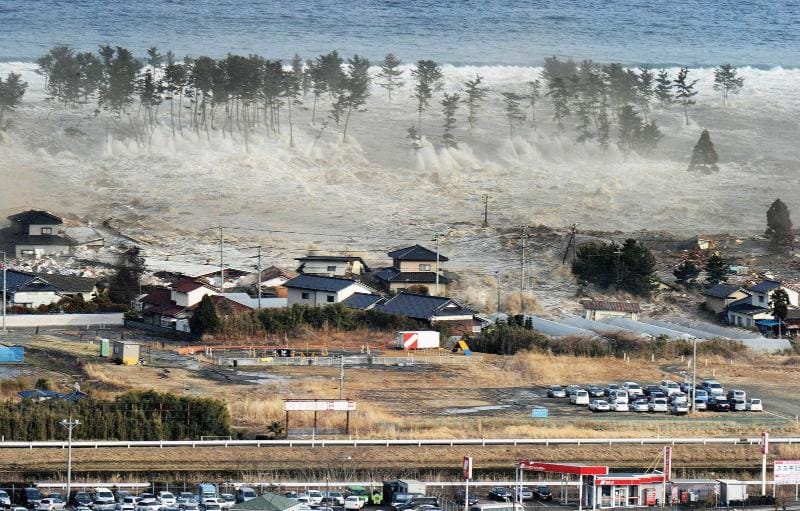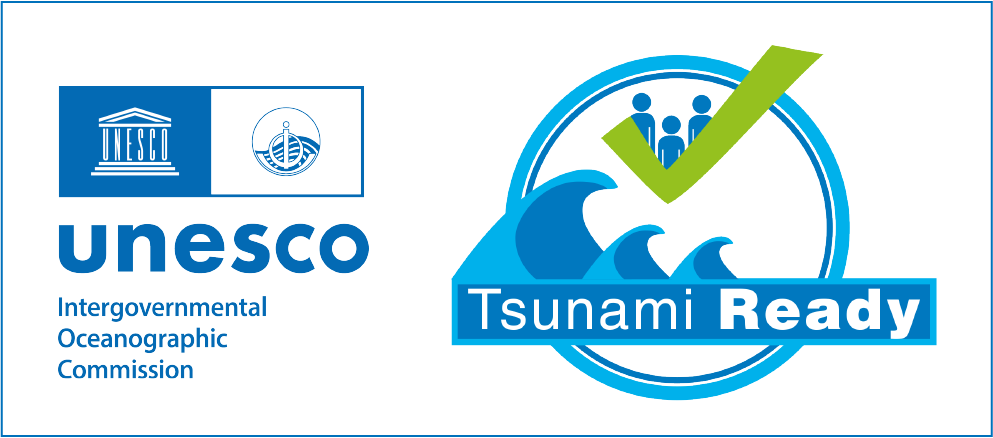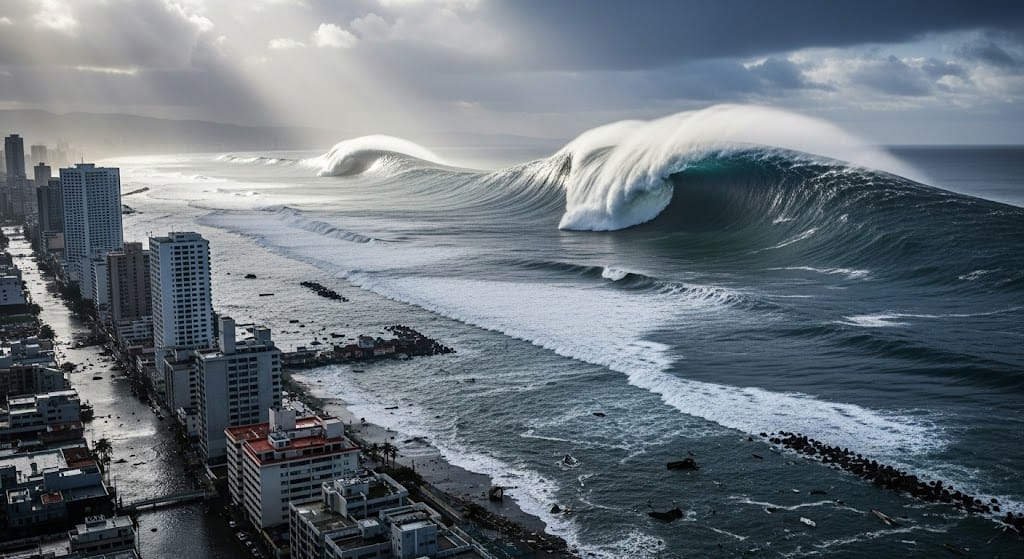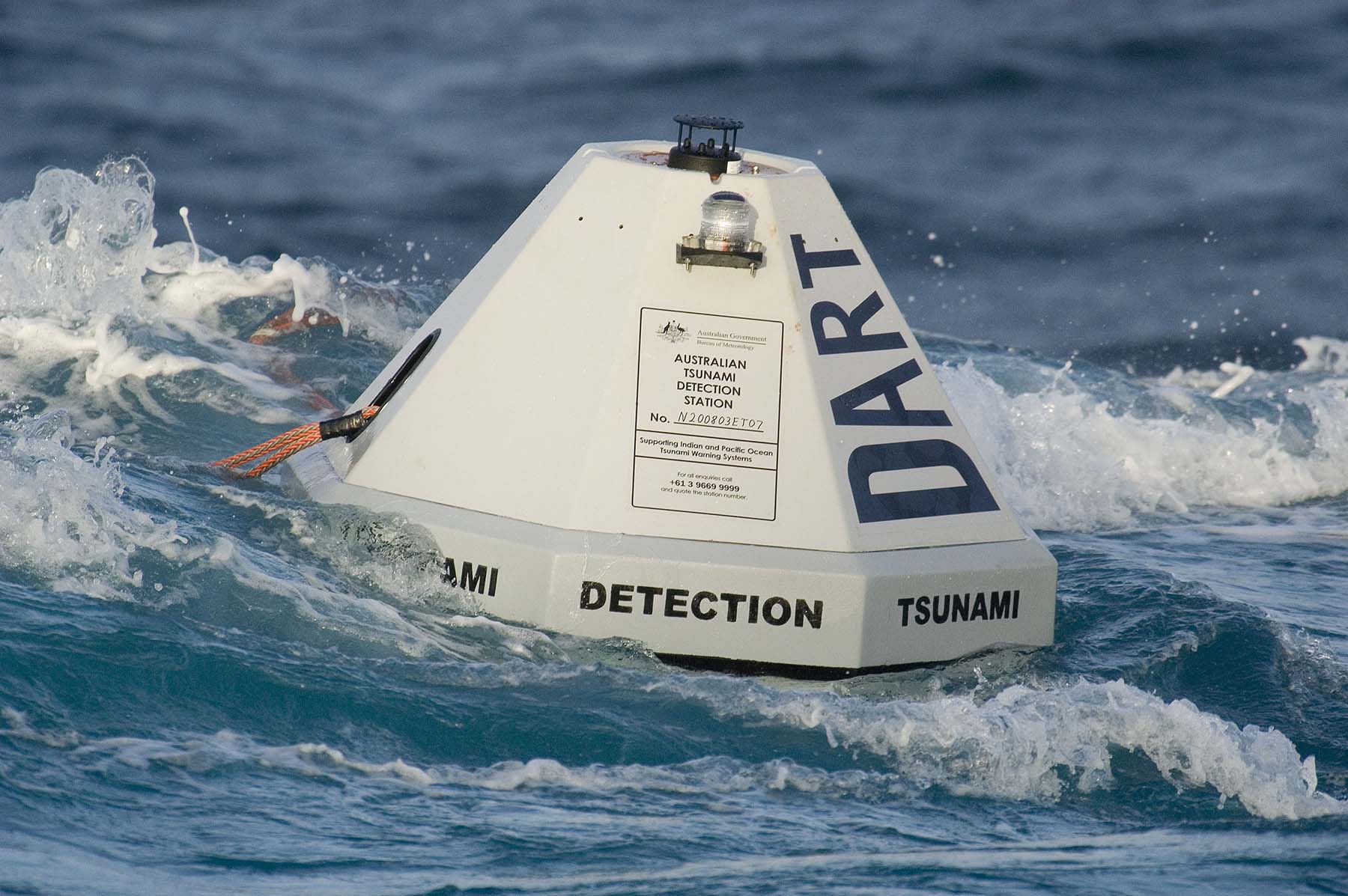When the Ocean Turns Deadly: Understanding Tsunamis in Our Changing World

Picture this: You're enjoying a perfect beach day when suddenly the ocean pulls back, exposing the seafloor for hundreds of meters. Fish flop on the sand, and boats that were floating moments ago now sit tilted on exposed mud. Your instinct might be to walk out and explore this strange phenomenon, maybe grab some of those stranded fish. But if you know what this means, you're already running for higher ground. The ocean is about to come back with a vengeance.
Tsunamis remain one of nature's most devastating forces, and despite all our technological advances, they continue to catch communities off guard. Just this past July 2025, an 8.8 magnitude earthquake near Russia's Kamchatka Peninsula sent tsunami waves racing across the Pacific, triggering evacuations from Japan to Hawaii and reminding us that these ocean giants respect no borders. While that event thankfully caused minimal damage, it served as a stark reminder that over 700 million people worldwide live in coastal areas vulnerable to these massive waves.

The Science Behind the Surge: More Than Just a Big Wave
Here's something that surprises many people: tsunamis have almost nothing in common with the waves you see at the beach. While regular waves are created by wind skimming across the water's surface, tsunamis involve the entire water column from seafloor to surface. Think of it this way – a normal wave is like shaking a blanket, but a tsunami is like pushing an entire swimming pool.
The physics are genuinely mind-blowing. In deep ocean waters, these waves can travel at speeds approaching 800 kilometers per hour – that's as fast as a commercial jet. Yet if you were on a ship in the middle of the Pacific when one passed underneath, you might not even notice it. The wave height in deep water is often less than a meter. It's only when these speed demons hit shallow coastal waters that they transform into monsters.
The transformation happens through something called the shoaling effect. As the tsunami enters shallower water, it slows down dramatically – from jet speed to about the pace of a car on a city street. But here's the crucial part: all that energy has to go somewhere. The wave compresses and grows taller, sometimes reaching heights of 30 meters or more. The 2011 Japan tsunami reached a staggering 40.5 meters in some areas – that's taller than a 13-story building.

What makes tsunamis particularly dangerous is their wavelength. While a typical ocean wave might have a wavelength of 100 meters, a tsunami's wavelength can stretch for hundreds of kilometers. This means when it hits shore, it's not just a wall of water that crashes and retreats. It's more like the entire ocean level suddenly rising and continuing to push inland for minutes or even hours. Survivors often describe it as if the ocean itself is invading the land.
The Triggers: When Earth and Ocean Collide
About 80% of tsunamis are triggered by underwater earthquakes, but not just any earthquake will do. The earthquake needs to be powerful (usually magnitude 6.5 or higher), occur at a shallow depth (less than 100 kilometers below the seafloor), and most importantly, cause vertical displacement of the ocean floor. This is why earthquakes along subduction zones – where one tectonic plate dives beneath another – are particularly dangerous. The sudden uplift or drop of the seafloor displaces massive volumes of water, setting the tsunami in motion.
But earthquakes aren't the only culprits. Underwater landslides, often triggered by earthquakes but sometimes occurring independently, can generate devastating local tsunamis. Research shows that while landslide tsunamis typically don't travel as far as earthquake-generated ones, they can actually be more deadly in the immediate area. The median wave height for landslide tsunamis is 4 meters, compared to just 0.4 meters for earthquake tsunamis. In fact, landslides have caused or contributed to 24% of all fatal tsunamis in recorded history.
Volcanic eruptions present another threat. The January 2022 eruption of Hunga Tonga-Hunga Ha'apai demonstrated this dramatically, generating tsunami waves observed across the entire Pacific basin. The explosion was so powerful it created atmospheric pressure waves that generated secondary "meteotsunami" effects worldwide – a phenomenon scientists are still studying.

Even more rare but theoretically possible are tsunamis caused by meteorite impacts. While we haven't witnessed one in recorded history, geological evidence suggests they've occurred in Earth's distant past. Given that we're tracking more near-Earth objects than ever before, this remains a consideration for long-term disaster planning.
Lessons Written in Tragedy: The Tsunamis That Changed Everything
The 2004 Indian Ocean tsunami remains the deadliest in recorded history, claiming between 227,000 and 280,000 lives across 14 countries. The images from that December 26th morning are seared into collective memory: tourists and locals alike standing on beaches, watching curiously as the water receded, unaware they were witnessing nature's warning sign. In Thailand's resort areas, many Western tourists had no concept of tsunami risk. The death toll included over 2,000 foreign visitors who simply didn't know to run when the ocean pulled back.
Yet within this tragedy lies a remarkable story of indigenous knowledge saving lives. On Indonesia's Simeulue Island, just 60 kilometers from the earthquake's epicenter, only 7 people died out of a population of 78,000. The difference? An oral tradition called "smong" passed down since a 1907 tsunami. Through songs and stories, generations had learned: when the ground shakes and the sea retreats, run for the hills immediately. Don't wait, don't gather belongings, just run. This traditional knowledge proved more effective than any modern warning system could have been in those crucial first minutes.

Japan's experience with the 2011 tsunami offers different lessons. Despite having the world's most advanced tsunami warning system and a population highly educated about tsunami risks, nearly 20,000 people still died. The disaster exposed the danger of overconfidence in engineering solutions. The Fukushima nuclear plant's 10-meter seawall seemed adequate based on historical data, but the 13-meter waves that arrived turned a natural disaster into a nuclear crisis that continues to impact global energy policy.
However, Japan also showed us what preparation can achieve. In the city of Kamaishi, years of earthquake and tsunami drills in schools paid off spectacularly. Following the principle of "tsunami tendenko" (roughly meaning "go separately and immediately to high ground"), 99.8% of the city's students survived. Teachers didn't waste time with roll calls or organizing groups – everyone knew exactly what to do and did it. The media called it the "Miracle of Kamaishi," though educators insisted it wasn't a miracle but the result of persistent preparation.
The recent California earthquake in December 2024 highlighted different challenges. While no major tsunami materialized, the event exposed weaknesses in public communication systems. Millions received tsunami warnings on their phones, but many couldn't find evacuation maps online or understand when waves might arrive at their specific location. The confusion that followed has prompted a complete overhaul of the National Weather Service's tsunami website, though budget constraints mean the improved version might not launch until late 2025.
The Warning Network: Racing Against Time
Today's global tsunami warning system is a marvel of international cooperation born from tragedy. Four regional warning systems now monitor the world's oceans, sharing data in real-time across national boundaries. The crown jewel of this network is the Deep-ocean Assessment and Reporting of Tsunamis (DART) system. These sophisticated buoys can detect tsunami waves as small as 1 centimeter in the deep ocean, using bottom pressure sensors that measure the weight of the water column above them.
When functioning properly, the system is impressive. During the July 2025 Kamchatka earthquake, Japan's J-Alert system issued warnings within 3 minutes, and automated drones in Sendai began broadcasting evacuation orders just 2 minutes after the quake. The Pacific Tsunami Warning Center tracked the waves across the entire Pacific basin, providing hours of advance warning to distant coastlines.
But technology is only part of the equation. The effectiveness of any warning system depends on public understanding and response. This is where programs like UNESCO's Tsunami Ready initiative come in. Communities seeking certification must meet 12 criteria, including conducting regular drills, maintaining 24-hour warning capability, and ensuring multiple ways to alert the public. As of 2024, dozens of communities across the Pacific have achieved this designation, though UNESCO's ambitious goal of having all at-risk communities certified by 2030 faces significant challenges.

The integration of artificial intelligence and machine learning is revolutionizing tsunami prediction. These systems can now differentiate between earthquake types, identifying which ones are likely to generate tsunamis and reducing false alarms that lead to warning fatigue. Some AI models can even predict wave heights and arrival times more accurately than traditional methods, buying precious extra minutes for evacuation.
Mobile technology has become a game-changer, especially in developing nations where smartphone penetration often exceeds traditional infrastructure. Apps can now provide location-specific evacuation routes, real-time updates in multiple languages, and even function offline once downloaded. During recent events, social media platforms have proven invaluable for rapid information sharing, though they also present challenges with misinformation spreading as fast as legitimate warnings.
Staying Alive: What Everyone Should Know
Understanding natural warning signs could save your life, especially in regions where formal warning systems might fail or not exist. A strong earthquake lasting 20 seconds or more near the coast should trigger immediate evacuation to higher ground – don't wait for official warnings. If you see the ocean suddenly recede, exposing the seafloor, you have minutes at most before the first wave arrives. Some survivors report hearing a sound like a freight train or jet engine as the tsunami approaches.
The evacuation itself requires quick but clear thinking. Vertical evacuation is often faster than horizontal – climbing to the third floor or higher of a reinforced concrete building can be safer than trying to drive inland, especially if roads are damaged or clogged with traffic. If you must evacuate horizontally, you need to get at least 1.6 kilometers inland or reach ground that's 30 meters above sea level.
Here's something crucial that many people don't realize: tsunamis aren't single waves but a series of surges that can continue for hours. The first wave is rarely the largest. In many historical tsunamis, the third or fourth wave caused the most damage. This is why you should never return to low-lying areas until officials give an all-clear – a process that might take many hours or even days.

Modern tsunami education emphasizes practical preparation over fear. Families in tsunami zones should have evacuation plans that account for different scenarios – what if it happens during the school day, at night, or when family members are separated? Important documents should be stored in waterproof containers or digitized in cloud storage. Go-bags with essentials should be ready, though the emphasis is always on saving lives first, property second.
Community-level preparation makes the biggest difference. Regular evacuation drills, clearly marked evacuation routes, and public education programs transform theoretical knowledge into muscle memory. In Japan, Chile, and other tsunami-prone nations, children grow up practicing evacuations the way American children practice fire drills. This normalization of preparedness removes panic from the equation when seconds count.
The Climate Connection: A Rising Threat
Here's a sobering reality that's only recently entered mainstream tsunami discussions: climate change is making tsunamis more dangerous. Not by creating more of them, but by amplifying their impact. With global sea levels rising an average of 3.4 millimeters per year (and accelerating), the baseline water level is higher when tsunamis strike. Research from China suggests that a 50-centimeter sea level rise could double tsunami risk in some coastal areas by 2060.
Rising seas aren't the only concern. Climate change is altering coastal geography through intensified erosion, changing sediment patterns, and affecting offshore slope stability. As permafrost melts in Arctic regions, previously stable underwater slopes become prone to landslides. Rapid glacial retreat can trigger devastating local tsunamis, as Alaska has experienced multiple times in recent decades.
The human factor compounds these risks. Coastal populations are booming just as coasts become more vulnerable. By 2050, an estimated 1.4 billion people will live in coastal areas. Many of these growing coastal cities are in developing nations with limited resources for tsunami preparedness. The expansion of tourism into previously undeveloped coastal areas puts millions of visitors at risk in unfamiliar environments where they might not recognize danger signs or know evacuation routes.
Looking Forward: Innovation and Cooperation
The future of tsunami preparedness lies not in preventing these waves – we can't – but in building resilience through a combination of cutting-edge technology, international cooperation, and community engagement. Fourth-generation DART systems now being deployed can transmit data via satellite every 15 seconds during an event, compared to 15-minute intervals for older systems. Fiber optic cables on the ocean floor, originally laid for internet traffic, are being repurposed as tsunami detectors, able to sense pressure changes from passing waves.

Perhaps most promising is the democratization of tsunami science. Crowd-sourced earthquake reporting through apps like MyShake can provide rapid ground-truth data. Citizens with smartphones become part of the detection network. Gaming technology is being used to create immersive tsunami evacuation training that's far more effective than traditional videos or pamphlets.
The international community has rallied around ambitious goals. UNESCO's Ocean Decade Tsunami Programme aims for 100% warning coverage in at-risk areas by 2030. While this might seem optimistic given current gaps, the pace of progress has been remarkable. Twenty years ago, the Indian Ocean had no regional warning system. Today, it has 25 seismic stations, 6 DART buoys, and coordination between 28 countries.
The Human Story: Resilience in the Face of Giants
Behind all the statistics and science are human stories of loss, survival, and resilience. Communities that have faced tsunamis often emerge with a profound respect for the ocean and a commitment to preparedness that transcends generations. In Chile, Japan, and Indonesia, tsunami education isn't just about drills and evacuation routes – it's about maintaining a cultural memory of these events.
The survivors of major tsunamis often become the most powerful advocates for preparedness. Petra Nemcova, who survived the 2004 Indian Ocean tsunami in Thailand, now serves as the UN's World Tsunami Awareness Day advocate. Her message is simple but powerful: the ocean gives us life, but we must respect its power and be prepared for its fury.

As we face an uncertain future with rising seas and growing coastal populations, the lessons from past tsunamis become more relevant, not less. We can't stop these waves, but we can choose how we respond to the risk they pose. Every evacuation route marked, every drill practiced, every warning system upgraded saves lives.
The next major tsunami isn't a matter of if, but when. Somewhere, tectonic plates are building tension that will eventually release. Somewhere, an underwater slope is approaching instability. The question isn't whether we'll face another tsunami disaster, but whether we'll be ready when we do. The technology exists, the knowledge is available, and the international framework is in place. What remains is the human element – the commitment to prepare, the wisdom to heed warnings, and the courage to act when every second counts.
In the end, tsunamis remind us of a fundamental truth: we share this planet with forces far greater than ourselves. Our survival depends not on conquering these forces but on understanding them, respecting them, and preparing for them. As coastal communities worldwide continue to grow and thrive, this ancient dance between humanity and the ocean continues, with each generation adding new steps to the choreography of survival.
